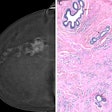Tuesday, December 1 | 11:10 a.m.-11:20 a.m. | RC315-13 | Arie Crown Theater
Practices that are beginning to use digital breast tomosynthesis (DBT) in combination with 2D mammography can expect to experience a learning curve, according to research conducted at Yale University. But it will diminish over time as radiologists become familiar with the technology.A team led by Dr. Reni Butler undertook a retrospective review of diagnostic mammograms performed before DBT was implemented at their institution and at three time points afterward (distributed over the course of 3.5 years).
The group recorded the total number of additional views, spot compression views, and magnification views acquired during a one-month period before DBT was installed, and they compared this information with results acquired at the three later time points. The researchers also tracked the number of "routine" studies -- that is, those that included only mediolateral-oblique (MLO) and craniocaudal (CC) views -- for each of these time points.
The data showed that radiologists' comfort with the technology increased over time, as evidenced by decreasing numbers of additional views requested per exam, according to Butler and colleagues. For example, 2D mammography required 2.07 additional views per exam, a number that declined to 0.53 additional views with 2D and DBT together at the final point in the study.
In addition, the number of routine diagnostic exams increased from 29.9% for 2D mammography to 41.4% at the first 2D-DBT time point, 44.9% at the second, and 73.3% at the third.
The data suggest radiologists can expect a learning curve when DBT is implemented into their practice, but as they become more comfortable with the technology in the diagnostic setting, fewer additional views will be necessary, Butler's group concluded.




















